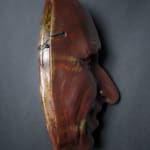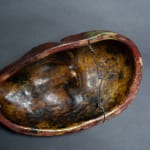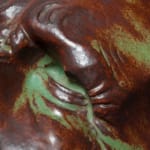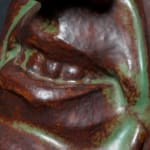Pierre Adrien Dalpayrat French, 1844-1910
Commedia dell’Arte Mask,
c. 1892
c. 1892
Collaboration with sculptor Alphonse Voisin-Delacroix
4.13h x 7w inches
4.13h x 7w inches
Stoneware
Further images
Exploring new firing and glazing techniques and their myriad effects on traditional forms was an exciting approach for many experimental turn-of-the-century ceramists. Here the acid green and dark umber glaze...
Exploring new firing and glazing techniques and their myriad effects on traditional forms was an exciting approach for many experimental turn-of-the-century ceramists. Here the acid green and dark umber glaze takes on the quality of copper patina. The metallic effect of the glazed stoneware thus produces a double mask in a clever play off the subject from the Comedia dell’Arte. There is also a macabre quality to the glaze as if acid green tones had become the new shadow. The era’s new forms of electric lighting, whose mercury components cast a sickly greenish hue, called forth profound states of inner dread, or ennui, and alienation which so often characterized modern urban life at the turn of the century. The popular Pulcinella-like mask motif found new relevance within this modern way of life. The partnership between Alphonse Voisin-Delacrox and Pierre-Adrien Dalpayrat was short but prolific. Following the untimely death of Voisin-Delacroix in 1893, Dalpayrat dropped the VD stamp of their partnership and used the exploding grenade to distinguish his pieces as he did on the underside of this mask.
6
of
6











